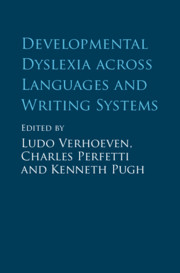Book contents
- Developmental Dyslexia across Languages and Writing Systems
- Developmental Dyslexia across Languages and Writing Systems
- Copyright page
- Contents
- Figures
- Tables
- Contributors
- 1 Introduction
- Part I Developmental Dyslexia across Languages and Writing Systems
- Part II Cross-Linguistic Perspectives on Developmental Dyslexia
- 11 Behavioral Precursors of Developmental Dyslexia
- 12 Neural Predictors of Developmental Dyslexia
- 13 Neurocognitive Markers of Developmental Dyslexia
- 14 Role of Visual Attention in Developmental Dyslexia
- 15 Morphological and Semantic Processing in Developmental Dyslexia
- 16 Modeling the Variability of Developmental Dyslexia
- 17 Modeling Developmental Dyslexia across Languages and Writing Systems
- 18 Etiology of Developmental Dyslexia
- 19 Intergenerational Transmission in Developmental Dyslexia
- Epilogue
- Index
- References
12 - Neural Predictors of Developmental Dyslexia
from Part II - Cross-Linguistic Perspectives on Developmental Dyslexia
Published online by Cambridge University Press: 27 September 2019
- Developmental Dyslexia across Languages and Writing Systems
- Developmental Dyslexia across Languages and Writing Systems
- Copyright page
- Contents
- Figures
- Tables
- Contributors
- 1 Introduction
- Part I Developmental Dyslexia across Languages and Writing Systems
- Part II Cross-Linguistic Perspectives on Developmental Dyslexia
- 11 Behavioral Precursors of Developmental Dyslexia
- 12 Neural Predictors of Developmental Dyslexia
- 13 Neurocognitive Markers of Developmental Dyslexia
- 14 Role of Visual Attention in Developmental Dyslexia
- 15 Morphological and Semantic Processing in Developmental Dyslexia
- 16 Modeling the Variability of Developmental Dyslexia
- 17 Modeling Developmental Dyslexia across Languages and Writing Systems
- 18 Etiology of Developmental Dyslexia
- 19 Intergenerational Transmission in Developmental Dyslexia
- Epilogue
- Index
- References
Summary
Dyslexia, or difficulty in learning to read that is not caused by a sensory deficit or lack of effort or education, affects readers of all languages (Caravolas,2005). Based on this definition, dyslexia cannot be diagnosed until children have demonstrated trouble with reading acquisition. However, it would be ideal to identify which children will go on develop reading problems before they struggle or fail to learn to read. Children who are identified early and who receive early intervention are likely to have better reading outcomes (Bowyer-Crane et al., 2008; Torgesen, 2004; Schatschneider & Torgesen, 2004; Vellutino, Scanlon, & Tanzman, 1998) and may suffer fewer of the negative consequences associated with poor reading. Further, an understanding of which children are at greatest risk for reading difficulties would allow educators and clinicians to allocate limited intervention resources to students who need them most. Extensive behavioral research has sought to answer this question and yet models predicting reading are rarely employed in practice.
- Type
- Chapter
- Information
- Developmental Dyslexia across Languages and Writing Systems , pp. 253 - 276Publisher: Cambridge University PressPrint publication year: 2019
References
- 5
- Cited by

